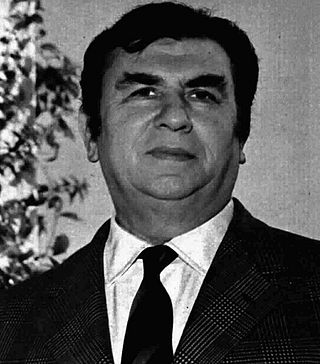
Beatrice Cenci was a Roman noblewoman who murdered her father, Count Francesco Cenci. She was beheaded in 1599 after a lurid murder trial in Rome that gave rise to an enduring legend about her.

Beatrix Cenci is an opera in two acts by Alberto Ginastera to a Spanish libretto by the composer and William Shand, based on the historical family of Beatrice Cenci, the Chroniques italiennes by Stendhal, and The Cenci by Percy Shelley. The first performance was on 10 September 1971 by the Opera Society of Washington in Washington, D.C., as part of the opening of the John F. Kennedy Center for the Performing Arts. The stage direction was by Gerald Freedman, with choreography by Joyce Trisler, and the conductor was Julius Rudel. New York City Opera first staged the work on 1 April 1973. The European premiere of Beatrix Cenci took place at the Geneva Opera in September 2000.

Luigi Cervi, better known as Gino Cervi, was an Italian actor. He was best known for portraying Peppone in a series of comedies based on the character Don Camillo (1952-1965), and police detective Jules Maigret on the television series Le inchieste del commissario Maigret (1964-1972).

Caltiki – The Immortal Monster is a 1959 black-and-white science fiction-horror film. The film's storyline concerns a team of archaeologists investigating Mayan ruins, who come across a creature that is a shapeless, amorphous blob. They manage to defeat it using fire, while keeping a sample of the creature. Meanwhile, a comet, which previously passed near the Earth around the time of the collapse of the Mayan civilization, is due to return, raising the possibility of a connection between the creature and the comet.

Les Miserables is a 1948 Italian drama film directed by Riccardo Freda. It is based on the Victor Hugo's 1862 novel Les Misérables and stars Gino Cervi as Jean Valjean, Valentina Cortese as Fantine and Cosette, and Hans Hinrich as Javert. After the financial success of Freda's previous film The Black Eagle, Freda worked a deal with Lux Film and began developing an adaptation of Les Misérables with Mario Monicelli, Vittorio Nino Novarese and Stefano Vanzina. The film was shot entirely in Rome.

Fausto Tozzi was an Italian film actor and screenwriter. He appeared in 70 films between 1951 and 1978. He wrote the script for The Defeated Victor, which was entered into the 9th Berlin International Film Festival. He also directed one film, Trastevere.

Sheba and the Gladiator is a 1959 historical drama film loosely pertaining to the Palmyrene Empire and its re-annexation back into the Roman Empire.

La morte non conta i dollari 1967 Italian spaghetti western film directed by Riccardo Freda. The film is about Lawrence White who returns to his hometown of Owell Rock with his sister to avenge the father's death at the hands of a gang. The leader of the gang, Doc Lester has recently appointed himself the gunslinger Boyd as the new sheriff.

The Black Eagle is a 1946 Italian historical adventure drama film directed by Riccardo Freda and starring Rossano Brazzi, Irasema Dilián and Gino Cervi. It was released as Return of the Black Eagle in the United States. The film is based on the unfinished 1832 Russian novel Dubrovsky by Alexander Pushkin (1799–1837). It was followed by a 1951 sequel Revenge of the Black Eagle, also directed by Freda.

Don Cesare di Bazan is a 1942 Italian historical adventure film directed by Riccardo Freda and starring Gino Cervi, Anneliese Uhlig and Paolo Stoppa. The film is set during the Catalan Revolt of the Seventeenth century. It is based on a play by Philippe Dumanoir and Adolphe d'Ennery. It marked the directoral debut of Freda who went on to be a leading commercial Italian filmmaker.
Caravaggio, il pittore maledetto is a 1941 Italian historical drama film directed by Goffredo Alessandrini and starring Amedeo Nazzari, Clara Calamai and Lamberto Picasso. Nazzari portrays the painter Caravaggio as a wayward genius. It was one of his favourite screen roles.

See Naples and Die is a 1952 Italian melodrama film directed by Riccardo Freda.

Murder Obsession, a.k.a. Fear, is a 1981 Italian giallo film directed by Riccardo Freda, and starring Laura Gemser and Anita Strindberg.

The Conspiracy of Torture is a 1969 Italian historical drama film directed by Lucio Fulci, starring Adrienne La Russa and Tomas Milian. The shooting title was originally La vera storia di Beatrice Cenci. It depicts the real life events of Francesco Cenci and his daughter Beatrice, emphasizing the more horrific elements of the story.

The Magnificent Adventurer is a 1963 adventure film directed by Riccardo Freda. It is loosely based on real life events of Benvenuto Cellini.

Beatrice Cenci is a 1941 Italian historical drama film directed by Guido Brignone and starring Carola Höhn, Giulio Donadio and Tina Lattanzi. It is one of several films portraying the story of the sixteenth century Italian noblewoman Beatrice Cenci.

Beatrice Cenci is a 1926 Italian silent historical film directed by Baldassarre Negroni and starring Maria Jacobini, Raimondo Van Riel and Franz Sala. It is one of several films portraying the story of the sixteenth century Italian noblewoman Beatrice Cenci.

Trapped in Tangiers is a 1957 spy film directed by Riccardo Freda and starring Edmund Purdom.

Two Million for a Smile is a 1939 Italian "white-telephones" comedy film directed by Carlo Borghesio and Mario Soldati and starring Enrico Viarisio, Giuseppe Porelli and Elsa De Giorgi.
La voce senza volto is a 1939 Italian "white-telephones" comedy film directed by Gennaro Righelli. It is part of the tradition of telefoni bianchi comedies, popular in Italy at the time.


















